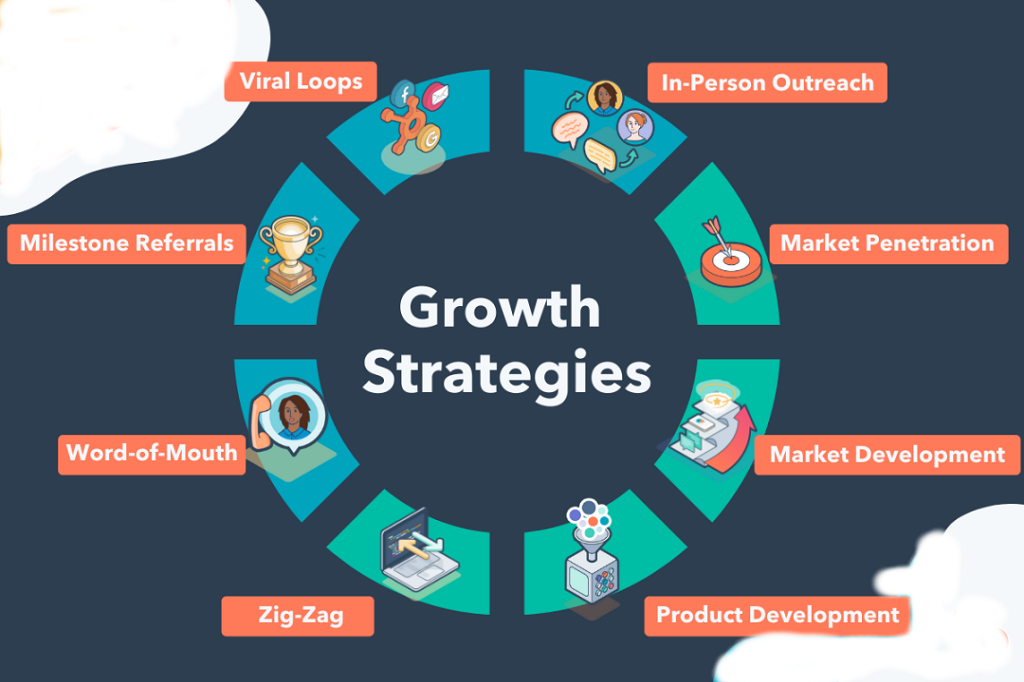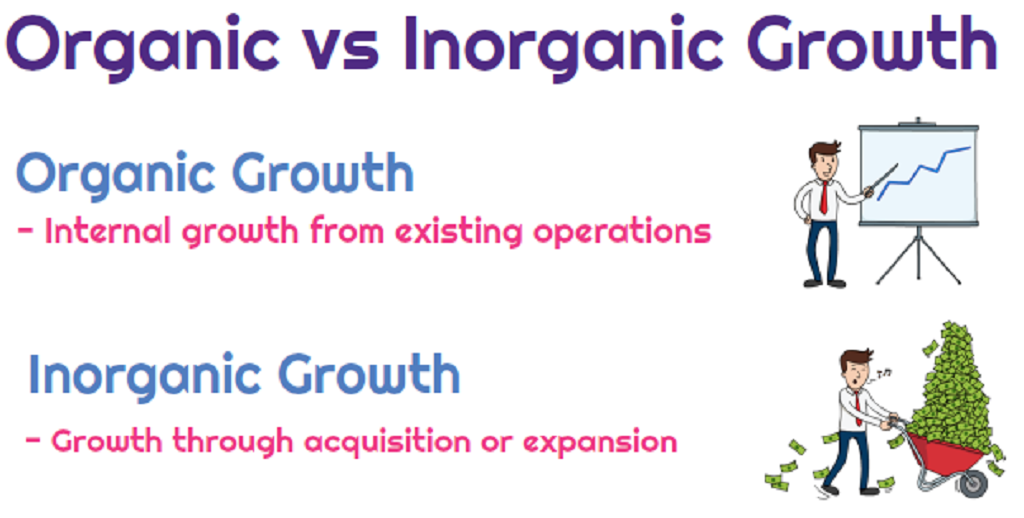Companies can adopt market penetration, market development, product development, and diversification as growth strategies. Market penetration aims to increase sales of existing products in existing markets to expand market share, while market development focuses on entering new markets.
Product development involves creating and launching new products, and diversification refers to entering new markets or industries with new products or services. When businesses seek to expand and achieve long-term success, they employ various growth strategies. Companies must deliberate and formulate effective plans to thrive in a competitive environment.
Adopting the right growth strategy can significantly impact a company’s success and profitability. Understanding the four possible growth strategies can aid in making informed decisions and charting a path toward sustainable business expansion. Let’s explore the four leading growth strategies companies can incorporate to enhance their market position and achieve sustained market growth strategies the better bean.
Types Of Business Growth
Businesses strive for growth, and there are various strategies they can adopt to achieve it. These strategies include market development, new product development, vertical integration, and organic growth. Each approach offers unique opportunities and challenges, contributing to the business’s expansion and success. Let’s delve into the specifics of these growth strategies:
Market Development
Market development involves expanding the customer base for existing products or services into new markets. This growth strategy often utilizes market research to identify untapped regions or demographics, allowing companies to extend their reach and increase sales.
New Product Development
New product development focuses on creating and introducing innovative offerings to meet evolving consumer needs. By launching fresh products or improving existing ones, businesses can attract new customers, enhance competitiveness, and capitalize on emerging trends.
Vertical Integration
Vertical integration encompasses merging with or acquiring businesses within the same supply chain, either backward (upstream) or forward (downstream). This strategy gives companies greater control over their production processes, ensures a more seamless supply chain, and can lead to cost savings and increased efficiencies.
Organic Growth
Organic growth emphasizes expanding a company’s operations internally through enhanced sales and marketing efforts, product diversification, and geographical expansion without relying on mergers or acquisitions. It allows businesses to develop steadily and sustainably while controlling their growth trajectory.
Conglomerate Growth
Conglomerate growth involves diversifying into unrelated industries, spreading the business’s risk across multiple sectors. While potentially lucrative, this strategy demands substantial resources and expertise to manage and operate diverse business endeavors successfully.
Four Major Growth Strategies
Businesses have several options to pursue growth and expansion. The four major growth strategies are market penetration, product development, and diversification. Each strategy offers a distinct approach to drive business growth and achieve market dominance.
Market Penetration
In Market Penetration, companies increase sales by promoting existing products or services within their current market. This strategy aims to gain a larger market share by converting potential customers and encouraging repeat purchases. Businesses achieve this growth by aggressive marketing, sales promotions, and advertising campaigns.
Market Development
Market Development involves expanding the existing products into new markets. Companies look for untapped or under-served geographical areas to reach new customer segments. This strategy may include researching the needs and preferences of target markets to adapt products or services accordingly.
Product Development
Product Development concentrates on creating or modifying new products to meet evolving customer demands or market trends. Businesses invest in RD, innovation, and technology to offer innovative solutions that differentiate themselves from competitors and attract and retain customers.
Diversification
Diversification involves expanding the company’s product or service offerings into new markets or industries that are different from its current operations. This strategy mitigates risks by spreading investments across various sectors and can create new revenue streams. It can be achieved through acquisition, joint ventures, or partnerships.
Organic Business Growth
Product development · Diversification. These strategies help companies expand their market share and reach new customers through various approaches, such as increasing existing product sales, entering new markets, developing new products, or diversifying into new industries. Organic business growth is a particularly effective and easy way for companies to achieve long-term success.
Easiest But Most Effective Way Of Business Growth
Organic business growth is the easiest but most effective way for companies to expand and thrive in the market. This strategy focuses on the company’s internal development without relying on external factors such as mergers or acquisitions. Instead, it emphasizes utilizing existing resources and capabilities to achieve sustainable growth.
When a company focuses on organic growth, it aims to increase revenue and market share by enhancing its current products or services, reaching new customers within existing markets, or expanding into new markets with its existing offerings. By leveraging their core strengths and competitive advantages, companies can gradually build a solid foundation for long-term success.
One of the key benefits of pursuing organic growth is the level of control it provides. Companies can maintain their autonomy and retain the essence of who they are without the need to integrate into a larger entity. This allows for a more seamless, growth-oriented process where decisions can be made swiftly and tailored to the specific needs and values of the company.
Moreover, organic growth strategies are often less risky than other growth strategies. They allow companies to grow sustainably, reducing the chances of overextending their resources or taking on excessive debt. Companies can minimize the risks of entering new markets or introducing new products or services by focusing on internal development and leveraging existing assets.
Organic growth also fosters a culture of innovation and learning within the company. As the company strives to improve its current offerings, it encourages continuous improvement, research, and development. This approach promotes adaptability and sets the foundation for future growth opportunities.
| Benefits of Organic Business Growth: |
| Control and Autonomy |
| Less Risk |
| Improved Innovation and Learning |
In conclusion, organic business growth is the easiest but most effective way for companies to expand and achieve long-term success. By utilizing existing resources and capabilities, companies can maintain control, reduce risk, and foster a culture of innovation. This strategy enables sustainable growth and sets the foundation for future opportunities.
Strategic Business Growth
Increase your market share by increasing sales of existing products or services on existing markets (market penetration), expand into new markets (market development), introduce new products or services (product development), or diversify into new industries or markets (diversification). These strategies can help drive strategic business growth and achieve long-term goals.
Works Well For Long-term Goals
Strategic business growth is a powerful approach for companies with long-term goals. Unlike short-term tactics, strategic growth focuses on sustainable expansion and building a solid foundation for the future. It involves carefully planning and executing actions that align with the company’s vision and objectives.
Strategic growth requires careful market trends, customer needs, and competition analysis. It is crucial to identify opportunities and develop strategies to capitalize on them. By taking a long-term perspective, companies can make well-informed decisions that lead to steady and controlled growth.
When it comes to strategic business growth, it is essential to have a clear understanding of the market landscape and the company’s unique value proposition. This enables the company to differentiate itself from competitors and position itself for success. By focusing on long-term goals, companies can steer their growth in a direction that is both sustainable and profitable.
Companies That Have Gone Through Organic Growth
Although beneficial for all companies, strategic business growth works particularly well for those who have already experienced organic growth. Organic growth refers to the natural development of a business through its internal resources, such as increasing sales, expanding its customer base, and developing new products or services.
For companies that have already gone through organic growth, strategic business growth acts as a catalyst to expand and strengthen their market position further. It allows them to leverage their existing resources and capabilities while exploring new opportunities and markets.
Companies that have achieved organic growth have established a strong foundation and a deep understanding of their industry. They have proven their ability to adapt to market changes and meet customer demands. Strategic growth builds upon this foundation, enabling companies to take calculated risks and explore new avenues for expansion.
By leveraging their existing strengths and expertise, companies that have gone through organic growth can effectively execute strategic growth initiatives. This combination of organic and strategic growth creates a potent recipe for long-term success.
Frequently Asked Questions Of What Are The 4 Possible Growth Strategies For Companies?
What Are The 4 Main Growth Strategies?
The four main growth strategies are market penetration, product development, and diversification. These strategies help businesses increase sales and expand into new markets or industries for long-term success.
What Are The 4 Types Of Business Growth?
The four types of business growth are market penetration, market development, product development, and diversification. Each strategy focuses on different areas of business expansion to increase market share and revenue.
What Are The 4 Key Business Strategies?
The four key business strategies are market penetration, product development, and diversification. Market penetration aims to increase sales and market share, while market development targets new markets. Product development involves creating new products. Diversification refers to entering new markets with new products.
What Are The Four Development Strategies?
The four development strategies are market penetration, product development, and diversification. Market penetration aims to increase sales of existing products or services in existing markets. Product development focuses on creating new products or improving existing ones. Market development involves entering new markets with existing products.
Diversification refers to the expansion into new industries or product categories. These strategies help businesses achieve growth and increase market share.
Conclusion
To achieve long-term success and expand your company’s presence, exploring growth strategies is crucial. The four possible growth strategies include market penetration, product development, and diversification. In crafting a Comprehensive audio-video marketing plan for your small business, it is essential to strategically integrate market penetration strategies to boost sales in existing markets, while simultaneously embracing market development tactics to successfully enter and thrive in new markets.
Product development involves creating new offerings, and diversification entails entering unrelated industries. However, organic business growth is the most effective and easiest way to grow, which allows for sustainable expansion. Additionally, strategic business growth and partnerships or mergers can also foster development.



